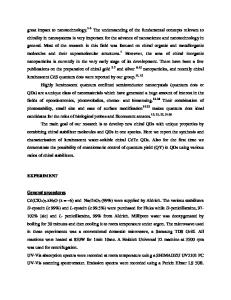Fluorescent Silica Nanoparticles Approach Brightness of Quantum Dots
- PDF / 1,829,011 Bytes
- 2 Pages / 612 x 792 pts (letter) Page_size
- 25 Downloads / 329 Views
RESEARCH/RESEARCHERS
Fluorescent Silica Nanoparticles Approach Brightness of Quantum Dots Potential applications for fluorescent nanoparticles include optical computing, sensors, and biological imaging. A core–shell architecture is particularly attractive for such materials because dyes with diverse functionality can be incorporated, size can be controlled, and monodispersity can be achieved. Recently, researchers from the Department of Materials Science and Engineering, the School of Applied and Engineering Physics, and the Department of Chemistry and Chemical Biology at Cornell University, produced a novel class of monodisperse silica-based fluorescent nanoparticles that are nearly as bright as quantum dots. As reported in the January 12 issue of NanoLetters (p. 113; DOI: 10.1021/ nl0482478), Cornell University researcher U. Wiesner and co-researchers employed a modified Stöber method to synthesize
MRS BULLETIN • VOLUME 30 • MARCH 2005
spherical nanometer-sized silica particles that encapsulate the organic dye tetramethylrhodamine isothiocyanate (TRITC). The researchers used fluorescence correlation spectroscopy (FCS) to characterize the concentration, brightness, size, and monodispersity of the nanoparticles, which the researchers call CU dots. The researchers used transmission electron microscopy to corroborate the size distribution found by FCS. In the first of a two-step synthesis process, a dye-rich core is formed by covalently conjugating TRITC to a silica precursor. The core, with a radius of 2.2 nm, is scarcely larger than the isolated dye molecule (radius of 1 nm) but its luminescence is not as bright as free TRITC, which suggested to the researchers that the dyerich core is heavily quenched, compared with free TRITC. In the second step, silica sol-gel monomers are added to form a dense silica network around the core, increasing the radius to 15 nm and the brightness by a factor of 30. The re-
searchers said that the shell protects the fluorophore from the solvent, which explains, at least in part, the brightness enhancement conferred by the shell. In addition, the CU dots show reduced photobleaching, compared with free TRITC, and little if any spectral shift. The researchers said that this increased photostability of the CU dots is further evidence of their inaccessibility to solvent. In addition, the researchers said that their approach is versatile in that it can be used to incorporate several fluorophore classes so that the entire UV–visible spectrum is accessible. Furthermore, it may be possible to specifically tune the nanoparticle structure to attain desired radiative fluorophore properties. Wiesner and co-researchers demonstrated the utility of the CU dots as biological imaging markers by labeling mucosal mast cell receptors. Although the researchers attained sufficient specificity with physical adsorption of the nanoparticles, they expect to achieve “greater con-
151
RESEARCH/RESEARCHERS
trol through covalent conjugation of biomolecules, which can be accomplished by applying surface chem
Data Loading...









